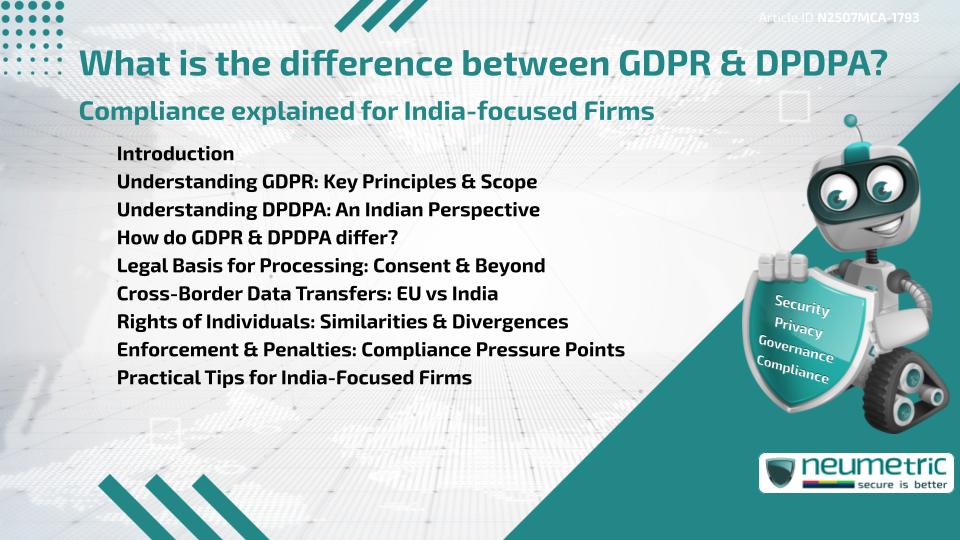Table of Contents
ToggleIntroduction
India’s Digital Personal Data Protection Act [DPDPA] & the European Union’s General Data Protection Regulation [GDPR] both aim to give individuals control over their personal data. While they share similar goals, the two frameworks differ in structure, terminology & regulatory approach.
So, how do GDPR & DPDPA differ? This article explains how these two Data Protection laws compare & how India-focused businesses can align with them effectively.
Understanding GDPR: Key Principles & Scope
Enforced since 2018, the General Data Protection Regulation [GDPR] stands as one of the world’s most robust & far-reaching privacy regulations. It covers any organisation, whether within or outside the EU, that handles personal data of individuals in the EU.
GDPR rests on seven (7) foundational principles, including:
- Lawfulness, fairness & transparency
- Purpose limitation
- Data minimisation
- Accuracy
- Storage limitation
- Integrity & confidentiality
- Accountability
Its territorial scope, extraterritorial reach & strong enforcement mechanisms make GDPR a global Standard for Data Privacy.
Understanding DPDPA: An Indian Perspective
India’s Digital Personal Data Protection Act [DPDPA] was enacted in 2023 & provides a structured Framework for the protection of Personal Data in the Indian context. Unlike GDPR, which outlines principles first, DPDPA is written in simpler language & focuses more on practical obligations.
DPDPA applies to:
- Data processed in India
- Data of individuals within India
- Data processed abroad in connection with providing goods or services to people in India.
DPDPA sets up the Data Protection Board of India to oversee compliance & handle disputes.
How do GDPR & DPDPA differ?
At the core, GDPR & DPDPA both seek to protect Personal Data & give individuals more control. However, the differences lie in their approach, enforcement, scope & definitions.
So, what is the difference between GDPR & DPDPA? Here are the key points of distinction:
- GDPR is principle-based while DPDPA is obligation-based
- GDPR sets stricter rules for sensitive data categories, whereas DPDPA treats all personal data under a single framework.
- GDPR allows for broad individual rights; DPDPA permits more restricted rights, subject to conditions
- GDPR requires Data Protection Officers [DPOs] & impact assessments; DPDPA does not mandate these for all entities
Legal Basis for Processing: Consent & Beyond
Under GDPR, there are six (6) lawful bases for processing, including consent, contract performance & legitimate interest. Consent must be freely given, informed & unambiguous.
In contrast, DPDPA places heavier emphasis on consent as the primary basis, although it includes limited legitimate uses where consent is not necessary (such as for state functions or emergencies).
So, what is the difference between GDPR & DPDPA? GDPR offers more flexibility while DPDPA leans more strictly on consent.
Cross-Border Data Transfers: EU vs India
GDPR regulates international data transfers through mechanisms such as adequacy decisions, Standard Contractual Clauses [SCCs] & Binding Corporate Rules [BCRs].
DPDPA allows the Indian Government to specify countries or territories where Personal Data can be transferred, & this list will be periodically notified. Here’s a unique & concise rephrasing: DPDPA, unlike GDPR, lacks data localisation mandates or clear adequacy standards for data transfers.
This leads to a clear gap—what is the difference between GDPR & DPDPA? GDPR provides a more transparent & structured transfer mechanism.
Rights of Individuals: Similarities & Divergences
GDPR provides individuals with broad rights, including access, correction, erasure, processing limits, data portability & the right to object.
DPDPA also includes access, correction & erasure rights, but under more limited conditions. It does not provide for data portability or objection to automated decisions.
So again, what is the difference between GDPR & DPDPA? GDPR offers broader individual empowerment.
Enforcement & Penalties: Compliance Pressure Points
GDPR fines can reach twenty (20) million euros or four percent (4%) of global revenue. Enforcement is done by independent supervisory authorities in each EU country.
DPDPA includes monetary penalties that can reach up to two hundred fifty (250) crore rupees for significant breaches. It establishes the Data Protection Board of India for adjudication but its independence & operational structure are still evolving.
What is the difference between GDPR & DPDPA? GDPR is enforced through a robust & decentralised regulatory framework.
Practical Tips for India-Focused Firms
For organisations operating in or targeting both the EU & Indian markets, Compliance can be challenging. Here’s what they can do:
- Map data flows & processing activities for both laws
- Build layered consent & preference management systems
- Draft separate Privacy notices aligned to each regulation
- Train internal teams on dual-Compliance obligations
- Keep records for both regulatory environments
Understanding what is the difference between GDPR & DPDPA? can help streamline Governance & avoid Compliance Risks.
Takeaways
- GDPR is more principle-driven while DPDPA is practical & obligation-focused
- Individual rights are broader under GDPR
- GDPR provides structured mechanisms for data transfers
- DPDPA focuses on Indian jurisdiction & offers simpler regulatory language
- Dual Compliance is crucial for global or India-focused digital businesses
FAQ
What is the difference between GDPR & DPDPA in terms of scope?
GDPR applies to any organisation processing data of EU residents, while DPDPA applies to data processed in or related to India.
How does consent work differently under GDPR & DPDPA?
GDPR allows multiple lawful bases; DPDPA relies mainly on User consent with limited exceptions.
Does DPDPA have a concept similar to GDPR’s Data Protection officer?
No, DPDPA does not mandate DPOs unless notified specifically, unlike GDPR which requires DPOs for certain processing activities.
Are there differences in how individual rights are protected?
Yes, GDPR offers wider rights such as data portability & objection, which are absent or limited in DPDPA.
What is the difference between GDPR & DPDPA in enforcement?
GDPR has strong independent authorities in every EU country; DPDPA uses a centralised Data Protection Board.
Is data localisation a requirement in DPDPA?
No, DPDPA does not mandate localisation but regulates transfers through notified lists of approved countries.
What about cross-border data transfers—how do they compare?
GDPR allows transfers through adequacy decisions & SCCs; DPDPA uses Government notifications for permitted transfers.
Are the penalties under DPDPA as severe as GDPR?
Both laws impose significant penalties, but GDPR’s fines are higher when converted to global currency & percentage of turnover.
Need help?
Neumetric provides organisations the necessary help to achieve their Cybersecurity, Compliance, Governance, Privacy, Certifications & Pentesting goals.
Organisations & Businesses, specifically those which provide SaaS & AI Solutions, usually need a Cybersecurity Partner for meeting & maintaining the ongoing Security & Privacy needs & requirements of their Clients & Customers.
SOC 2, ISO 27001, ISO 42001, NIST, HIPAA, HECVAT, EU GDPR are some of the Frameworks that are served by Fusion – a centralised, automated, AI-enabled SaaS Solution created & managed by Neumetric.
Reach out to us!





